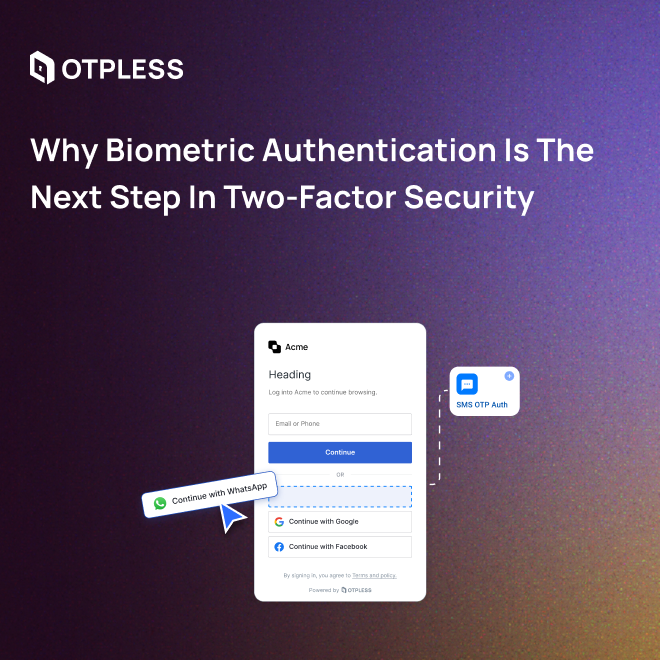Two-factor authentication (2FA) has become a standard security measure for online accounts, offering an additional layer of protection beyond a simple username and password. While traditional 2FA methods, such as one-time passwords (OTPs) delivered via SMS or email, have proven effective in preventing unauthorized access, they can be inconvenient for users and vulnerable to cyber-attacks.
Enter biometric authentication as a second factor for 2FA. By leveraging unique physical characteristics, such as fingerprints, facial features, or iris patterns, biometric authentication offers a secure and convenient login experience for users.
But what exactly is biometric authentication and how does it work? Simply put, biometric authentication is the process of verifying a person’s identity using their unique physical characteristics. This can be done through various biometric modalities, including fingerprints, facial recognition, iris scans, voice recognition, and more.
When using biometric authentication as a second factor for 2FA, users are required to provide both their standard login credentials (username and password) and a biometric identifier. This allows for an added layer of security, as it becomes much more difficult for attackers to impersonate a user with both login credentials and a unique biometric identifier.
One of the major advantages of biometric authentication is its convenience. Unlike OTPs, which require users to remember and enter a constantly changing code, biometric authentication can be performed with a simple scan or touch. This not only makes the login process more efficient for users but also reduces the likelihood of errors or mistakes, such as mistyping a code or entering the wrong OTP.
Another benefit of biometric authentication is its increased security. As mentioned earlier, OTPs can be vulnerable to cyber attacks, such as SIM swapping or phishing scams. Biometric authentication, on the other hand, is much harder to forge or replicate, making it a more secure option for 2FA.
In addition to the security and convenience benefits, biometric authentication also has the potential to improve the user experience. By eliminating the need for OTPs, users are spared the inconvenience of constantly having to enter codes or waiting for SMS messages to arrive. This can lead to increased satisfaction and loyalty from users, as they experience a smoother and more seamless login process.
Of course, like any security measure, biometric authentication is not foolproof. There have been instances of biometric systems being hacked or tricked, such as with the use of artificial fingerprints or 3D-printed faces. However, these instances are rare and the overall security of biometric authentication is much higher compared to traditional 2FA methods.
In conclusion, biometric authentication as a second factor for 2FA offers a secure and convenient login experience for users. Its convenience eliminates the need for OTPs, while its increased security makes it a safer option compared to traditional 2FA methods. As technology continues to advance, we can expect to see biometric authentication becoming an increasingly popular option for online account protection.
One crucial factor to consider when implementing biometric authentication is the accuracy and reliability of the biometric modality being used. Some modalities, such as fingerprints or iris scans, tend to be more accurate and reliable compared to others, such as voice recognition or facial recognition. It is important for companies to carefully evaluate the accuracy and reliability of the biometric modality they choose to implement, as this can impact the overall security and effectiveness of the biometric authentication system.
It is also important to ensure that the biometric data being collected is handled securely and in accordance with privacy laws and regulations. This includes protecting the data from unauthorized access or misuse and obtaining explicit consent from users before collecting and storing their biometric data.
In addition to the security and privacy considerations, there are also logistical challenges that companies may face when implementing biometric authentication. For example, there may be initial costs associated with purchasing and implementing the necessary biometric hardware and software. There may also be ongoing maintenance and support costs, as well as the need to train employees and users on how to properly use the biometric authentication system.
Despite these challenges, the potential benefits of biometric authentication as a second factor for 2FA make it a promising security measure for companies to consider. As technology continues to advance and biometric systems become more accurate and reliable, we can expect to see biometric authentication becoming an increasingly popular option for online account protection.
OTPLESS is transforming the landscape of user verification and app security with its innovative solution that replaces traditional OTPs. By leveraging cutting-edge technology, OTPLESS offers a seamless, secure, and user-centric authentication experience without the vulnerabilities associated with OTPs.
Through the integration of various authentication technologies, OTPLESS ensures robust security while simplifying the user login process. This includes silent network authentication, SMS OTPs, and other passwordless channels tailored to diverse user preferences.
Clients adopting OTPLESS have reported a significant increase in login conversion rates by 25%*, showcasing the effectiveness and user appeal of this solution. Implementing OTPLESS into your login page is straightforward and can be done in just a few minutes, providing immediate benefits for your users and enhancing overall security.
Experience the future of authentication with OTPLESS and discover a new standard of user verification that prioritizes security, convenience, and user satisfaction.

